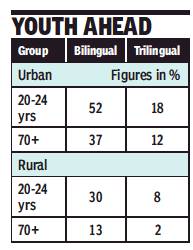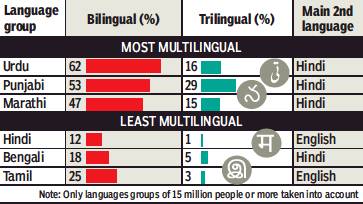Linguistic skills, ability: India
(Created page with "{| class="wikitable" |- |colspan="0"|<div style="font-size:100%"> This is a collection of articles archived for the excellence of their content.<br/> Additional information ma...") |
|||
| Line 11: | Line 11: | ||
=Indians who speak more than one language= | =Indians who speak more than one language= | ||
| − | == | + | ==52% urban youth are bilingual, 18% speak three languages== |
[https://epaper.timesgroup.com/Olive/ODN/TimesOfIndia/shared/ShowArticle.aspx?doc=TOIDEL%2F2018%2F11%2F07&entity=Ar00302&sk=AE66873D&mode=text Rema Nagarajan, November 7, 2018: ''The Times of India''] | [https://epaper.timesgroup.com/Olive/ODN/TimesOfIndia/shared/ShowArticle.aspx?doc=TOIDEL%2F2018%2F11%2F07&entity=Ar00302&sk=AE66873D&mode=text Rema Nagarajan, November 7, 2018: ''The Times of India''] | ||
| Line 33: | Line 33: | ||
In urban areas, the gender gap is very small compared to the rural areas when it comes to those knowing two languages. Interestingly, the highest proportion of those who know three languages is urban men in the 50-69 age group, about 20% or one in five. | In urban areas, the gender gap is very small compared to the rural areas when it comes to those knowing two languages. Interestingly, the highest proportion of those who know three languages is urban men in the 50-69 age group, about 20% or one in five. | ||
| + | |||
| + | == Hindi, Bengali speakers are the least multilingual == | ||
| + | [https://epaper.timesgroup.com/Olive/ODN/TimesOfIndia/shared/ShowArticle.aspx?doc=TOIDEL%2F2018%2F11%2F14&entity=Ar00105&sk=455C6264&mode=text Rema Nagarajan, Hindi, Bengali speakers least multilingual groups in India, November 14, 2018: The Times of India] | ||
| + | |||
| + | [[File: The most and least multilingual peoples in India.jpg|The most and least multilingual peoples in India <br/> From: [https://epaper.timesgroup.com/Olive/ODN/TimesOfIndia/shared/ShowArticle.aspx?doc=TOIDEL%2F2018%2F11%2F14&entity=Ar00105&sk=455C6264&mode=text Rema Nagarajan, Hindi, Bengali speakers least multilingual groups in India, November 14, 2018: The Times of India]|frame|500px]] | ||
| + | |||
| + | India’s largest linguistic groups — Hindi and Bengali speakers — are also the least multilingual. They have the smallest share of people who know even one more language. | ||
| + | |||
| + | Among the scheduled languages that have more than 15 million speakers each, those who speak Urdu as their mother tongue are the most multilingual with 62% knowing one more language, typically Hindi. | ||
| + | |||
| + | Punjabis are the next most multilingual with 53% knowing two languages. | ||
| + | |||
| + | Recently released Census data shows that for 87% of bilingual Punjabis, Hindi was the other language they knew and for 11% of the Punjabis, it was English. | ||
| + | |||
| + | |||
| + | '''Among 520m Hindi speakers, 12% bilingual''' | ||
| + | |||
| + | Punjabi speakers also accounted for the largest proportion of people speaking three languages among the scheduled languages. Of the trilingual Punjabis, 82% knew English and about 17% knew Hindi. | ||
| + | |||
| + | In the third largest linguistic group, of over 83 million Marathi speakers, 47% of them speak one more language. For most (88%) of these, Hindi was the second language they knew. Among the 520 million Hindi speakers, only 12% were bilingual, the largest chunk among them being the 32 million who knew English. This was followed by 60.5 lakh who knew Marathi, an indication of the migration from the north to Maharashtra. Of the 79 lakh Hindi speakers who were trilingual, English was third language for 32 lakh. | ||
| + | |||
| + | Among 97 million Bengali speakers, just 18%, or 17 million, were bilingual, nearly half of this lot also knowing Hindi. | ||
| + | |||
| + | In the south, the proportion of those who knew a language other than their mother tongue was the same in most states and at a relatively low level. The proportion ranged from 27% among Kannada and Malayalam speakers to 25% among Tamil and Telugu speakers. Interestingly, unlike in the north where the second language known was mostly Hindi, in the south there were much larger numbers for whom English was the second language. | ||
| + | |||
| + | Not surprisingly, smaller language groups tend to be more multilingual. This was true both within the 22 scheduled languages — where for instance 82% of Konkani speakers and 79% of Sindhi speakers knew another language — and even more so for non-scheduled languages. The best example of this was the 11,574 Lahauli speakers of whom 88% knew one more language, mostly Hindi, and 41% were trilingual. | ||
Revision as of 06:16, 20 November 2018
This is a collection of articles archived for the excellence of their content. |
Indians who speak more than one language
52% urban youth are bilingual, 18% speak three languages
Rema Nagarajan, November 7, 2018: The Times of India

From: Rema Nagarajan, November 7, 2018: The Times of India

From: Rema Nagarajan, November 7, 2018: The Times of India
The generation gap is showing in the number of languages Indians speak. Young Indians (age 20-24 years) are two to three times more likely to be bilingual or trilingual than their older family members. Recently released census data shows that just over a quarter of the country’s population is bilingual and 7% is trilingual. In the 1990s, less than 20% of Indians were bilingual.
The overall figure hides the huge difference between urban and rural India. While barely 22% are bilingual and just 5% trilingual in rural areas, in urban India, 44% are bilingual and 15% trilingual. The higher the age group, the lesser the proportion of people who know more than one language whether in rural or urban India. Up to the age of 14, there is no gender variation in the number of languages known. From 15 years onwards there is a significant difference in the proportion of males and females who are bilingual. This suggests that an important determinant of how many languages people know is the job market and the need to travel out of one’s home state to find a job.
India has 23 constitutionally recognised languages. With more than half the population speaking Hindi and English education spreading faster than ever, the number of multilingual people will only grow with time. Several studies have shown that multilingual exposure improves cognitive skills and social abilities. From the 20-24 age group — which is also the most multilingual — the gender gap keeps increasing with increasing age till in the 70+ age group where 25% of men are bilingual compared with just 16% of women, a difference of 9 percentage points. While the gap is not as wide for those who are trilingual, the pattern is the same, of a widening gap with increasing age.
Even within urban and rural areas, there are variations depending on the age group and gender.
Most bilingual people are in 20-24 age group
The highest proportion of bilingual people in the country is in the 20-24 age group in urban India, 52%. There is no gender difference in how many languages a person knows in urban areas till 15 years, though in rural areas the difference starts much earlier, from the 10-14 years age group, probably an indication of the number of girls who do not go to school and hence know only their mother tongue.
In urban areas, the gender gap is very small compared to the rural areas when it comes to those knowing two languages. Interestingly, the highest proportion of those who know three languages is urban men in the 50-69 age group, about 20% or one in five.
Hindi, Bengali speakers are the least multilingual

From: Rema Nagarajan, Hindi, Bengali speakers least multilingual groups in India, November 14, 2018: The Times of India
India’s largest linguistic groups — Hindi and Bengali speakers — are also the least multilingual. They have the smallest share of people who know even one more language.
Among the scheduled languages that have more than 15 million speakers each, those who speak Urdu as their mother tongue are the most multilingual with 62% knowing one more language, typically Hindi.
Punjabis are the next most multilingual with 53% knowing two languages.
Recently released Census data shows that for 87% of bilingual Punjabis, Hindi was the other language they knew and for 11% of the Punjabis, it was English.
Among 520m Hindi speakers, 12% bilingual
Punjabi speakers also accounted for the largest proportion of people speaking three languages among the scheduled languages. Of the trilingual Punjabis, 82% knew English and about 17% knew Hindi.
In the third largest linguistic group, of over 83 million Marathi speakers, 47% of them speak one more language. For most (88%) of these, Hindi was the second language they knew. Among the 520 million Hindi speakers, only 12% were bilingual, the largest chunk among them being the 32 million who knew English. This was followed by 60.5 lakh who knew Marathi, an indication of the migration from the north to Maharashtra. Of the 79 lakh Hindi speakers who were trilingual, English was third language for 32 lakh.
Among 97 million Bengali speakers, just 18%, or 17 million, were bilingual, nearly half of this lot also knowing Hindi.
In the south, the proportion of those who knew a language other than their mother tongue was the same in most states and at a relatively low level. The proportion ranged from 27% among Kannada and Malayalam speakers to 25% among Tamil and Telugu speakers. Interestingly, unlike in the north where the second language known was mostly Hindi, in the south there were much larger numbers for whom English was the second language.
Not surprisingly, smaller language groups tend to be more multilingual. This was true both within the 22 scheduled languages — where for instance 82% of Konkani speakers and 79% of Sindhi speakers knew another language — and even more so for non-scheduled languages. The best example of this was the 11,574 Lahauli speakers of whom 88% knew one more language, mostly Hindi, and 41% were trilingual.